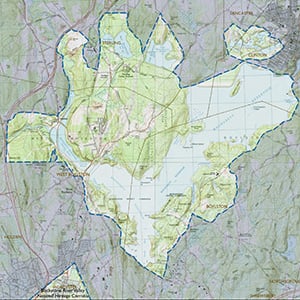Important Bird Area Sites in Massachusetts
Important Bird Area: Wachusett Reservoir
Site Summary
Nominated By
Mark Lynch, Sheila Carroll, Fran McMenemy
Size
62,270 acres
Towns and Counties
Boylston, Clinton, Sterling, West Boylston; Worcester
Ownership
Department of Conservation and Recreation, private
Major Habitats
oak-conifer forest, emergent freshwater wetland, powerline, lake/pond, river/stream, migratory stopover site
Land Use
hunting/fishing, water supply, suburban/residential (around periphery), undeveloped (some)
IBA Criteria
- Category 1: Waterfowl: The site regularly supports 500 or more waterfowl at any one time. The designation "waterfowl" includes birds such as loons, grebes, cormorants, geese, ducks, coots, and moorhens.
Site Description
Wachusett Reservoir is the second largest body of freshwater in Massachusetts. The watershed is managed by the Department of Conservation and Recreation (DCR) as part of greater Boston's water supply. There are several small islands that have been used by loons and gulls as breeding sites. There are numerous coves and inlets that are favored by migrating waterbirds. The surrounding forest is mostly typical reservoir plantings including stands of Red Pine. The Quinapoxet River flows into the reservoir at the northwest corner at Thomas Basin. Wachusett Reservoir is a popular fishing spot, though boat fishing is prohibited and shore fishing is restricted. Forested areas along Quinapoxet River, especially northwest of Thomas Basin and along River Road, are very attractive to winter finches and Boreal Chickadees as well as owls including the Barred and Saw-whet. Included in this IBA are several nearby ponds that are commonly used by migratory waterfowl that fly back-and-forth to the reservoir. All these ponds consistently have migratory species including scaup, mergansers, goldeneyes, Buffleheads and Ruddy Ducks. Part of the IBA is a small marshy peat bog locally called Sterling Peat. In the past, the peat was farmed and sold. The remnant is a shallow cattail marsh surrounding peat beds favored by migratory waterfowl, postbreeding egrets, shorebirds, and breeding Wood Ducks and rails. Least Bitterns have been detected calling here in the last few years. A sizable (60+ pairs) Bank Swallow colony is found in a sand mound by the water.
Current Conservation Status
Perhaps the greatest concern is keeping gulls off the reservoir. This has involved firing off ordnance, shooting off guns (no live charge), putting up netting around exposed sandbars, and going out in boats (based on personal observation). Though this has typically been restricted to the northeastern section of the reservoir, the reservoir is an area of extreme importance to migratory waterbirds, which are undoubtedly affected by these measures.
Ornithological Significance
Wachusett Reservoir has always been attractive to large numbers of migratory waterfowl including Red-throated Loons, Red-necked Grebe, scoters, and Long-tailed Ducks, which usually have a more coastal affinity. In addition, it has hosted breeding Common Loons for almost two decades now, usually one to three pairs. In 2001, three pairs of loons have nested in a combination of natural and human-made sites. A small breeding colony of Herring Gulls once existed on the northeast end of the reservoir proper on Cunningham Ledge. Ten pairs were observed nesting in 1984. By 1992 there were 55 nests counted and in 1993 49 nests. This spot also hosted the first documented inland breeding record of Great Black-backed Gulls when in August of 1985 a pair was seen feeding regurgitated food to two chicks. A pair of Great Black-backed Gulls nested again in 1986. This colony has since been eradicated as part of the gull-control program. In recent years, small numbers of Bald Eagles have started to be regular in the late fall and into winter. Recent fall hawk-watching totals conducted from Tower Hill indicate that this site may also be significant for migrant raptors. Sterling Peat is attractive to migratory waterfowl, postbreeding egrets, and small numbers of waterfowl. Least Bitterns have been noted at Sterling Peat in the breeding season. Areas of planted conifers along the Quinapoxet River on River Road are consistently attractive to winter finches and Boreal Chickadees.
Data Sources
Bird Observer, The Chickadee, personal observations.




